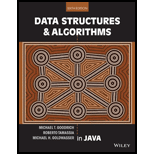
Concept explainers
Explanation of Solution
Recursive method to arrange the elements is less than or equal to “n”:
Create the method arrangingElements() that accepts the input parameter as “a”, “n”, “low”, and “high” to arrange the elements is less than or equal to “n” before any integer greater than “n” by calling this method recursively.
Method definition:
//Define the arrangingElements() method
public static void arrangingElements(int a[], int n, int low, int high)
{
//Check whether the "low" is greater than "high"
if(low > high)
{
/*Check whether the "low" is less than array length and "a[low]" is greater than "a[a.length-1]".*/
if(low < a.length && a[low] > a[a.length - 1])
{
/*Assign the "a[low]" value to temporary variable. */
int temp = a[low];
/*Assign the "a[a.length-1]" value to "a[low]". */
a[low] = a[a.length - 1];
//Assign the "temp" value to "a[a.length-1]"
a[a.length - 1] = temp;
}
//Return it
return;
}
/*Otherwise, call arragingElements() method recursively to arrange the elements is less than or equal to "n" before any integer greater than "n". */
else
{
//Check whether the "a[low]" is less than "n"
if(a[low] < n)
//Increment "low" by "1"
low++;
/*Otherwise, check whether "a[low]" is equal to "n". */
else if(a[low] == n)
{
/*Check whether "a[a.length-1]" is not equal to than "n". */
if(a[a.length - 1] != n)
{
/*Assign the "a[low]" value to temporary variable. */
int temp = a[low];
/*Assign the "a[a.length-1]" value to "a[low]". */
a[low] = a[a.length - 1];
/*Assign the "temp" value to "a[a.length-1]"> */
a[a.length - 1] = temp;
}
//Otherwise, increment "low" by "1"
else
low++;
}
//Otherwise, swap the array elements
else
{
/*Assign the "a[low]" value to temporary variable. */
int temp = a[low];
//Assign the "a[high]" value to "a[low]"
a[low] = a[high];
//Assign the "temp" value to "a[high]"
a[high] = temp;
//Decrement "high" by "1"
high--;
}
/*Call arrangingElements() method recursively to find the elements are less than or equal to "n". */
arrangingElements(a, n, low, high);
}
}
Explanation:
In the above code,
- In the arrangingElements() method,
- It accepts the input parameter as “a”, “n”, “low”, and “high”...
Want to see the full answer?
Check out a sample textbook solution
Chapter 5 Solutions
Data Structures and Algorithms in Java
- Draw an ERD that represents a book in a library system. Be sure to add relationship types, key attributes, attributes and multiplicity on the ERD.arrow_forward2:21 m Ο 21% AlmaNet WE ARE HIRING Experienced Freshers Salesforce Platform Developer APPLY NOW SEND YOUR CV: Email: hr.almanet@gmail.com Contact: +91 6264643660 Visit: www.almanet.in Locations: India, USA, UK, Vietnam (Remote & Hybrid Options Available)arrow_forwardProvide a detailed explanation of the architecture on the diagramarrow_forward
- hello please explain the architecture in the diagram below. thanks youarrow_forwardComplete the JavaScript function addPixels () to calculate the sum of pixelAmount and the given element's cssProperty value, and return the new "px" value. Ex: If helloElem's width is 150px, then calling addPixels (hello Elem, "width", 50) should return 150px + 50px = "200px". SHOW EXPECTED HTML JavaScript 1 function addPixels (element, cssProperty, pixelAmount) { 2 3 /* Your solution goes here *1 4 } 5 6 const helloElem = document.querySelector("# helloMessage"); 7 const newVal = addPixels (helloElem, "width", 50); 8 helloElem.style.setProperty("width", newVal); [arrow_forwardSolve in MATLABarrow_forward
- Hello please look at the attached picture. I need an detailed explanation of the architecturearrow_forwardInformation Security Risk and Vulnerability Assessment 1- Which TCP/IP protocol is used to convert the IP address to the Mac address? Explain 2-What popular switch feature allows you to create communication boundaries between systems connected to the switch3- what types of vulnerability directly related to the programmer of the software?4- Who ensures the entity implements appropriate security controls to protect an asset? Please do not use AI and add refrencearrow_forwardFind the voltage V0 across the 4K resistor using the mesh method or nodal analysis. Note: I have already simulated it and the value it should give is -1.714Varrow_forward
 C++ Programming: From Problem Analysis to Program...Computer ScienceISBN:9781337102087Author:D. S. MalikPublisher:Cengage LearningProgramming Logic & Design ComprehensiveComputer ScienceISBN:9781337669405Author:FARRELLPublisher:Cengage
C++ Programming: From Problem Analysis to Program...Computer ScienceISBN:9781337102087Author:D. S. MalikPublisher:Cengage LearningProgramming Logic & Design ComprehensiveComputer ScienceISBN:9781337669405Author:FARRELLPublisher:Cengage New Perspectives on HTML5, CSS3, and JavaScriptComputer ScienceISBN:9781305503922Author:Patrick M. CareyPublisher:Cengage Learning
New Perspectives on HTML5, CSS3, and JavaScriptComputer ScienceISBN:9781305503922Author:Patrick M. CareyPublisher:Cengage Learning EBK JAVA PROGRAMMINGComputer ScienceISBN:9781337671385Author:FARRELLPublisher:CENGAGE LEARNING - CONSIGNMENT
EBK JAVA PROGRAMMINGComputer ScienceISBN:9781337671385Author:FARRELLPublisher:CENGAGE LEARNING - CONSIGNMENT Programming with Microsoft Visual Basic 2017Computer ScienceISBN:9781337102124Author:Diane ZakPublisher:Cengage Learning
Programming with Microsoft Visual Basic 2017Computer ScienceISBN:9781337102124Author:Diane ZakPublisher:Cengage Learning Systems ArchitectureComputer ScienceISBN:9781305080195Author:Stephen D. BurdPublisher:Cengage Learning
Systems ArchitectureComputer ScienceISBN:9781305080195Author:Stephen D. BurdPublisher:Cengage Learning





